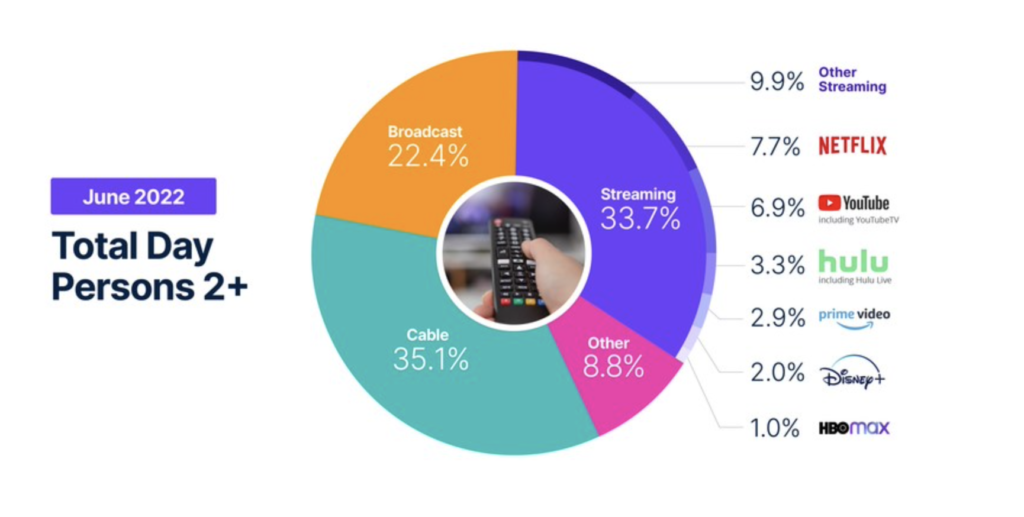As Netflix reaches a plateau and saturation point in total subscribers, the leading streamer is looking for new and different ways to grow its business in a challenging environment. Netflix currently has 220 million subscribers globally, but that number has declined by nearly 1 million subscribers in the most recent quarter (Q2 ’22). As growth hungry investors become bearish on the company, Netflix stock is down over 68% from its 52-week high of $701, reached in November 2021. In an effort to find new growth vectors, Netflix announced plans to launch a new ad-supported streaming tier in ‘early 2023’, during its Q2 2022 Earnings Review.

Despite the gloomy outlook, Netflix remains a powerhouse of the attention economy.
In its most recent market report, Nielsen announced streaming video represents more than 1/3rd of all TV Viewing Time in the United States. Reporting, Netflix is the #1 streaming provider representing 7.7% of total TV viewing time, followed closely by YouTube. In an earlier report, Nielsen also stated that Netflix had the #1 most time spent watching television, when compared to the leading broadcast networks and streaming platforms. Time spent watching Netflix was nearly double the #2 entry on the list (CBS) and nearly equaled the combined totals of the #2 (CBS) and #3 (NBC) networks.

What we know so far about Netflix’s ad-supported offerings is limited.
Details on the ad-supported offering are limited at the moment. Here is what we know so far according to Netflix’s Q2 2022 Earnings Call. The ad-supported tier will be separate, and in addition to, existing ad-free tiers as Netflix does not want to compromise the user experience for current customers. In addition, due to rights issues, not all current content will be available on the ad-supported tier. Netflix plans to roll the offering out in ‘early 2023’ to countries with a mature advertising market and will look to expand to other markets over several years in what it’s calling an ‘iterative process’. Earlier in July, the company announced that it had selected Microsoft to be its exclusive technology and sales partner for the ad-supported service. Microsoft will be responsible for ad sales and execution, with a revenue share back to Netflix.
So, what does all this mean for advertisers and brands?
A few key questions remain to be answered, such as how will Netflix and Microsoft price out their offering. Early indications are that Netflix views itself as a ‘premium content’ provider, so expect pricing in line with, or slightly higher than, similar offerings from Hulu and ‘prestige’ linear TV. Other unknowns include targeting capabilities, ad formats, and measurement. Given their current share of consumer attention, Netflix is poised to shake up the market for TV ad dollars. In an increasingly digital age, advertisers will soon find a new option for reaching cord-cutters and cord-nevers. The biggest question of all, ultimately, is how will consumers react to the new offering and how many of them will actually sign up. At any rate, Netflix is bullish on their ability to disrupt the world of entertainment once again:
“We’re excited by the opportunity given the combination of our very engaged audience and high quality content, which we think will attract premium CPMs from brand advertisers. Like most of our new initiatives, our intention is to roll it out, listen and learn, and iterate quickly to improve the offering. So, our advertising business in a few years will likely look quite different than what it looks like on day one. Over time, our hope is to create a better-than-linear-TV advertisement model that’s more seamless and relevant for consumers, and more effective for our advertising partners.” – Netflix Q2 ’22 Earnings Call



